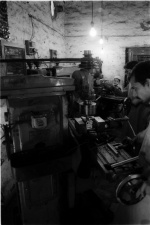Gun politics in Pakistan
| This page is part of a series on
| |
| Gun politics | |
|---|---|
|
| |
| |
Australia |
| |
Brazil |
| |
Canada |
| |
Czech Republic |
| |
Finland |
| |
Germany |
| |
Honduras |
| |
Italy |
| |
Jamaica |
| |
Kuwait |
| |
Mexico |
| |
New Zealand |
| |
Norway |
| |
Pakistan |
| |
South Africa |
| |
Switzerland |
| |
United Kingdom |
| |
United States |
Gun politics in Pakistan refers to the long-standing tradition of owning and carrying guns especially among Pashtun men in Khyber Pakhtunkhwa (Northwest Frontier Province, or NWFP)[1] and generally in the whole country. There are estimated 20 million AK 47's in public use when country's total population is around 180 million. The use of heavy weaponry in Pakistan's tribal culture is common which includes use of rocket launchers, short,medium and long range rockets, anti aircraft guns, mortars etc. which are made locally. Hand guns are often considered harmless in Pakistan's heavy weapon culture. The gun culture in NWFP is linked to the "twin pillars of Pathan tribal society,"[1] melmastia (hospitality) and badal (revenge). One of the centers of gun manufacturing is the town of Darra Adam Khel, near Peshawar, which was historically known for the Lee Enfield .303; however, the town now produces ordnance including the AK-47, the mini-Kalashnikov, and hand-held firearms, including the James Bond pen gun (see Khyber Pass Copy).[1]
Khyber Pakhtunkhwa is the smallest province of Pakistan with rugged and hilly terrain. Pashtun tribal feuds are common and guns are used both for protection and self-defense. In the rural society Swat, the gun culture arose in part out of the traditional antagonism between a man and his tarbur (cousin, father's brother's son). According to Charles Lindholm:[2]

The pervasive hostility between the sons of brothers led to the development of a network of alliances within every village that divided it across lineages into two approximately equal parties, called dulla. Every man belonged to the dulla opposite that of his tarbur. This division ramified throughout the (Swat) valley, so that all of the nearly one million inhabitants visualized themselves as members of one of two eternally warring parties. 
Old customs and a culture of honor also promote the prevalence of guns. In NWFP, where the strong and tough Pashtuns reside, carrying a gun or a Kalashnikov is a sign of honour and respect. Similarly, much of mainstream Pakistani culture, including Balochi, Sindhi, Punjabi and Kashmiri culture is highly influenced by guns and the use of aerial firing on special occasions such as weddings is a common practice. Guns are also considered to be the jewels of a man thus the social necessity emerging as an intimidating component of provincial culture.
Pakistani citizens and special category of foreigners can legally own firearms. A license is required to purchase a firearm which involves payment of fees, a processing time ranging from a few days to months and registration of the firearm with the local authorities. Present laws allow ownership of handguns of any caliber (at one time this was restricted to an upper limit of .38-caliber). Shotguns above 12-gauge are not allowed. A civilian permit for a full-automatic weapon may be issued by a local police agency, but typically the firearm may not leave the state in which the permit was issued.[3]
A person may keep a firearm at his/her place of residence, in one's vehicle and concealed on person; public display is prohibited (though this law is honored more in the breach than in the observance, especially outside urban areas and in particular by private bodyguards of politicians). Special permits are required for carrying firearms during times when local authorities impose restriction on public gatherings to preempt civil unrest or protests that can turn ugly. In large cities, facilities exist for gun enthusiasts to practice shooting on targets, etc.
In the last decade, gun culture has been linked with Islamist terrorism and drug trafficking,[4] which has arisen due to the prevalence of militants in NWFP of Pakistan.
[edit] Notes
- ↑ 1.0 1.1 1.2 Palin, Michael. 2005. Himalaya. Weidenfeld Nicolson Illustrated. 288 pages. ISBN 0297843710.
- ↑ Lindholm, Charles. 1979. "Contemporary Politics in a Tribal Society: Swat District, NWFP, Pakistan" Asian Survey, 19(5):485-505.
- ↑ http://online.wsj.com/article/SB123120431026355961.html
- ↑ http://www.yespakistan.com/pakistanday/enhance_security.asp
